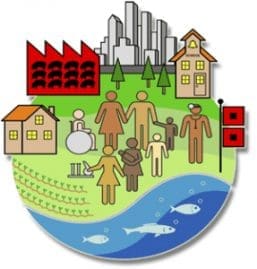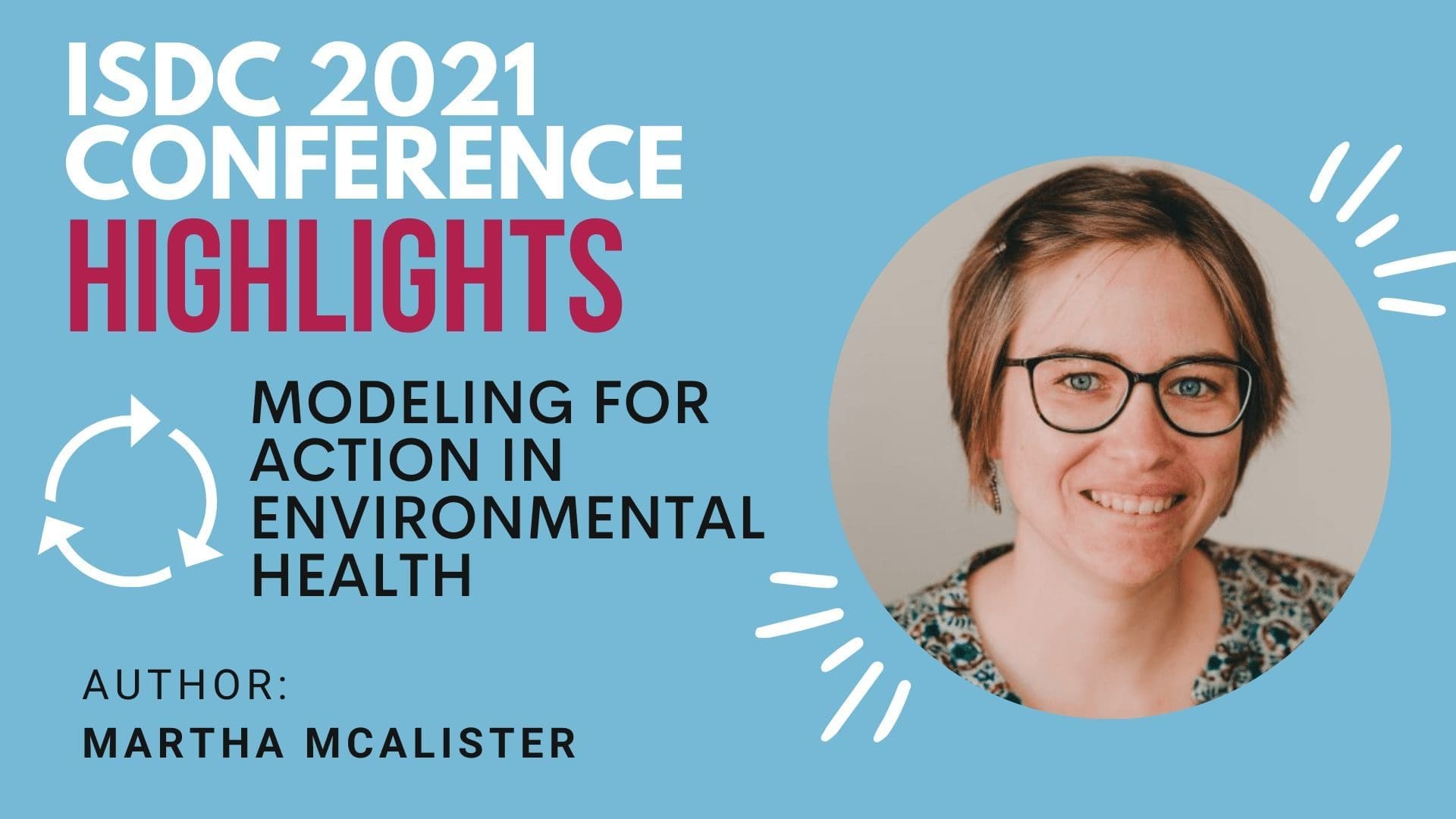ISDC 2021 Highlights: Modeling for Action in Environmental Health
The International System Dynamics Conference (ISDC) convenes practitioners who demonstrate what’s new and developing in their fields with System Dynamics. This section of the WiSDom Blog, “Conference Highlights,” asks system dynamicists to spotlight key presentations and innovations presented at the conference.
– Conference Highlights Editorial Team: Saras Chung, Will Glass-Husain, Jack Homer, Sara Metcalf, and Remco Peters with coordination by Christine Tang
This highlight by Martha McAlister shares a first-time conference attendee’s perspective on modeling for action in environmental health.

Modeling for Action in Environmental Health
When environmental risks remain unmitigated, they end up hurting our ability to lead healthy and productive lives. These risks are often concentrated where populations are the most marginalized, thereby creating or contributing to unjust health disparities. Environmental health and justice problems can be complex, as they intersect multiple domains (social, economic, political, legal, institutional, etc.) and may involve years or decades of lag time, starting from the accumulation of multiple exposures and ending in life-threatening chronic illnesses.
System Dynamics offers opportunities for modelers to engage with broad audiences to address environmental health and justice challenges. Modelers can elicit public or expert participation before, during, and after the modeling process to promote confidence in the results and to encourage holistic learning that goes beyond narrowly epidemiological approaches.
As a first-time attendee of the International System Dynamics Conference, I wanted to learn how System Dynamics is being used in the environmental health context and about the challenges of applying System Dynamics to such complex problems.
The first hint came during the Student-Organized Colloquium, where keynote speaker Dr. Josephine Musango stated that “engagement is crucial.” As the conference progressed, I heard several presenters talk about their use of participatory modeling to study global environmental and health issues.
Laurent Smets spoke about using group model building with virology experts to connect early vaccine research and development to the user requirements at the “last mile” in low- and middle-income countries.
Kelsey Werner described workshops with local community groups in India (organized by the Social Systems Design Lab at Washington University) to model factors affecting their use of less harmful liquefied petroleum gas (e.g., for cooking) in place of solid fuels like firewood or charcoal..
Others reported on using System Dynamics simulation interfaces that engage stakeholders. As Juliette Rooney-Varga put it, this requires translating well-informed scientific models into meaningful, recognizable intervention levers and outputs.
Allyson Beall King, presenting on her work with Tyler Opp, echoed this concept of scientific translation in describing their model of toxic sediments in Lake Coeur d’Alene. They wanted to make sure this model would not only satisfy scientists but also be fully accessible and transparent for the public.
I also learned from Daniel Kliem’s talk about how to involve experts in participatory modeling. He said that if a simulation was the ultimate goal, then one should “fail fast” by developing the quantitative model sooner rather than later. He also advised modelers to remember that we are the translators and integrators of others’ knowledge, and as such we should always give those experts the credit they are due.
This last point reminded me of something that the other Student-Organized Colloquium keynote speaker, Dr. Irene Headen, said about one of the strengths of System Dynamics: the process allows modelers to collect and integrate multiple perspectives on a single topic.
The conference is a heady experience for a first-time attendee like myself. Thinking about the presentations I attended, I realize that none precisely addressed environmental health and justice per se. But that doesn’t really matter, because the presenters made it easy to see how their experiences and insights have broad application, and I look forward to applying these ideas in my own work.
Martha McAlister – mcalisterm@usf.edu
Martha is a PhD student of Environmental Engineering at the University of South Florida. She studies the efficacy and sustainability of environmental health interventions. Martha’s participation in the International System Dynamics Conference was supported by USF NRT Strong Coasts (National Science Foundation under Grant No. 1243510). Any opinions, findings, and conclusions or recommendations expressed in this material are those of the authors and do not necessarily reflect the views of the National Science Foundation, USF, or NRT Strong Coasts.
Check out the Society’s SIGs – including Environmental SIG and Health Policy SIG
Recent Posts
Society Governance Updates
Society Governance Updates Welcome, Allyson! New President Allyson Beall King joined the Policy Council as our 2024 President. Her primary role is as director of the Washington State University School of the Environment, which focuses on regional ecologies and our...
Call for Presenters: Seminar Series
Call for Presenters: Seminar Series We at the System Dynamics Society are continually seeking vibrant and knowledgeable presenters for our ongoing Seminar Series. As we unfold the calendar, there’s always a place for more insights, experiences, and expertise to enrich...
Honoring Excellence: A Glimpse into the Awards of the International System Dynamics Conference
Honoring Excellence: A Glimpse into the Awards of the International System Dynamics Conference The International System Dynamics Conference brings together experts, practitioners, and students to exchange ideas, showcase real-world applications, and celebrate...
Upcoming Events

MIT System Dynamics Seminar | Approaches to Encouraging Health Exchange Participation
You are invited to attend the System Dynamics Seminar being held on Friday, April 26th from 12:30-2:00pm EST in the Jay W. Forrester conference room, E62-450, or via Zoom: https://mit.zoom.us/j/94114971874 (Password: SDSP24). Our guest speaker will be Soheil Ghili...
Recent Business cases
Solving Bottlenecks in Dairy Production Facilities with System Dynamics
Solving Bottlenecks in Dairy Production Facilities with System Dynamics EXECUTIVE Summary FrieslandCampina faced potential bottlenecks in production due to the merging of two factories. They hired SD&Co which employed system dynamics simulation models to predict...
A Design Value Calculator: A System Dynamics Boardgame
A Design Value Calculator: A System Dynamics Boardgame EXECUTIVE Summary Product design is a specific form of complex innovation that touches all areas of an organization’s management. While entrepreneurs recognise the value of design, they often tend to focus...
The World Bank Uses System Dynamics to Identify Root Causes of Poverty
The World Bank Uses System Dynamics to Identify Root Causes of Poverty EXECUTIVE Summary Madagascar has one of the highest poverty rates in the world. In 2022, an astonishingly three out of every four people in Madagascar lived below the poverty line. Poverty has...


